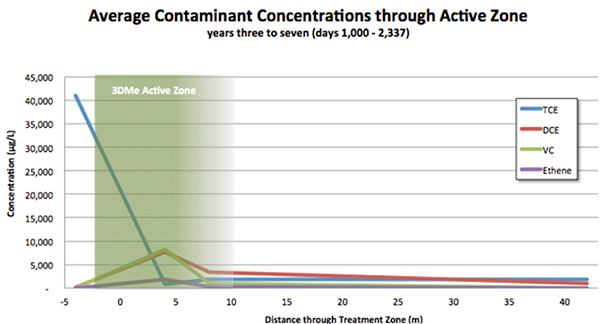A barrier treatment pilot study demonstrates the longevity of 3-D Microemulsion

Summary
A large volume of a limestone bedrock aquifer was impacted with chlorinated solvents from industrial activity on the site. The TCE contamination had accumulated in a highly impacted ‘source’ area, with concentrations indicative of DNAPL. The dissolved phase plume from the contamination extended over a kilometre downgradient and presented a risk to nearby water abstraction points.
Treatment
By drilling wells to the bottom of the contaminant plume at 50 m BGL, 3-D Microemulsion® (3DMe) could be injected into the source area on a widely spaced injection grid and in the plume area in a series of barriers. As 3DMe self-distributes in the subsurface, the number of injection points could be minimised, making the treatment economically viable.
It was decided that a pilot study should be completed prior to the main works and 3DMe was injected into two wells on the edge of the source area in order to provide a barrier effect, which could be monitored downgradient. Due to economic conditions, development of the site was postponed and the length of the pilot trial effectively became extended.
The graph shows a plot of the average concentrations of chlorinated solvents in the wells transecting the barrier over a period between 3 to 7 years. It can be seen that the barrier has produced the full reductive dechlorination of an ongoing influx of approximately 40,000 μg/L for this entire tine.
What’s Special?
- The ability of 3DMe to self-distribute has allowed the remediation to be designed on a wide (10 m) spacing, reducing the drilling and application cost and making treatment affordable for this very large site.
- The pilot study has shown that 3DMe can fully reductively dechlorinate solvent contamination in a limestone bedrock and that no build-up of breakdown products occurs.
- The pilot study shows that 3DMe provides a controlled release of electron donor for an extended period from a single application.



 Americas
Americas Europe
Europe Français
Français Deutsch
Deutsch Italiano
Italiano Español
Español


